中国气象学会主办。
文章信息
- 刘明竑, 任宏利, 张文君, 任鹏飞. 2018.
- LIU Minghong, REN Hongli, ZHANG Wenjun, REN Pengfei. 2018.
- 超强厄尔尼诺事件对中国东部春夏季极端降水频率的影响
- Influence of super El Niño events on the frequency of spring and summer extreme precipitation over eastern China
- 气象学报, 76(4): 539-553.
- Acta Meteorologica Sinica, 76(4): 539-553.
- http://dx.doi.org/10.11676/qxxb2018.021
-
文章历史
- 2017-11-16 收稿
- 2018-03-21 改回
2. 中国气象局国家气候中心气候研究开放实验室, 北京, 100081;
3. 中国气象局-南京大学气候预测研究联合实验室, 南京, 210023;
4. 中国气象科学研究院, 北京, 100081
2. Laboratory for Climate Studies, National Climate Center, China Meteorological Administration, Beijing 100081, China;
3. CMA-NJU Joint Laboratory for Climate Prediction Studies, Nanjing 210023, China;
4. Chinese Academy of Meteorological Sciences, Beijing 100081, China
厄尔尼诺-南方涛动(ENSO,El Niño-Southern Oscillation)是热带太平洋地区海-气耦合系统中最强的年际变化信号,其发生、发展往往引起全球范围的天气、气候异常(Rasmusson,et al,1982;Philander,1983;Trenberth,et al,1998;Wallace,et al,1998)。中国地处亚洲东部,受东亚季风影响深远,其气候异常与ENSO密切相关(Huang,et al,1989;陶诗言等,1998;Wang,et al,2000;Zhang,et al,1996)。因此,深入认识ENSO相关的气候影响及其机理问题,对中国短期气候预测工作具有重要的指导意义。
长期以来,ENSO与中国降水异常的关系一直受到人们关注。研究表明,ENSO一般通过影响东亚季风的强、弱进而调控中国的降水,不同阶段对中国降水异常的影响有所不同(符淙斌等,1988;Zhang,et al, 1996, 2002;Gong,et al,1999)。例如,在厄尔尼诺衰减年春季,从中国华南延伸至日本南部降水均异常增多;夏季,主要表现为江淮流域降水偏多、华南和华北地区相对偏少的异常分布特征(刘永强等,1995;赵振国,1996;Zhang,et al,1999;金祖辉等,1999)。伴随着季节平均降水变率的增大,极端降水事件的发生也会相应受到影响。中国极端降水时、空变化复杂,具有明显的区域性和季节性特征(翟盘茂等,2003;Zhai,et al,2005;陈海山等,2009)。李威等(2009)研究发现,在厄尔尼诺年冬、春季和拉尼娜年夏、秋季,中国极端降水事件频发,多数地区更易发生在ENSO暖位相出现后半年左右。王苗等(2013)的研究则表明,空间上,厄尔尼诺衰减年春、夏季北方多极端降水事件,而南方分布形势较为复杂。Xiao等(2017)也指出,厄尔尼诺发展年中国中部地区极端降水事件通常较少,而次年中国东部地区则更易发生极端降水事件。目前对极端降水与厄尔尼诺事件之间联系的研究仍然很少,多以统计厄尔尼诺年极端降水分布为主且缺少定论,其特征与机理成因均需进一步深入研究。
2015/2016年发生了继1982/1983和1997/1998年之后又一次超强厄尔尼诺事件,引起广泛关注。此次事件持续时间长、强度大,相应的气候响应非常显著(翟盘茂等,2016;邵勰等,2016;袁媛等,2016)。毕宝贵等(2017)指出,在超强厄尔尼诺衰减年,极端降水和强对流天气发生的频次明显较常规年份多,而其他厄尔尼诺事件期间极端降水的多发特征并不明显。因此,按照厄尔尼诺事件强度加以区分,可能是研究其对极端天气影响的一个关键点。对于超强厄尔尼诺事件的典型特征及其影响,前人已经有了一些认识(Latif,et al,2015;Chen,et al,2016;张文君等,2016;任宏利等,2017)。最近的研究发现,ENSO除了自身的直接影响外,还能通过与其他信号相互作用产生新的衍生模态。例如,ENSO与热带太平洋地区年循环信号发生非线性相互作用,会衍生出一种经向非对称的海-气异常模态(图 1),被称为ENSO-年循环组合模态(ENSO-AC combination mode,简称C-mode)(Stuecker,et al,2013),该模态峰值出现在厄尔尼诺衰减年冬末春初,一般在强厄尔尼诺事件中较为显著。在强厄尔尼诺衰减年的春、夏季,C-mode对中国东部地区降水异常有显著的贡献(李海燕等,2016;Zhang,et al, 2016a, 2016b)。目前对超强厄尔尼诺事件以及C-mode影响的研究主要关注季节平均降水异常,对更易引发灾害的极端降水的影响还知之甚少。因此,本研究在考虑C-mode作用的基础上,专注于超强厄尔尼诺事件气候影响,探讨其衰减年春、夏季中国极端降水事件发生概率的变化以及可能成因,以期进一步加深对超强厄尔尼诺气候影响的认识,为中国极端降水事件的预测提供一些新的思路和参考。
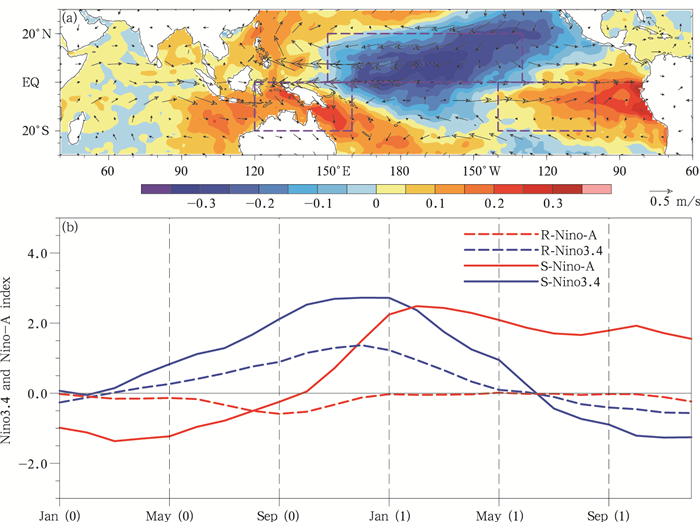
|
| 图 1 (a) 热带印度-太平洋区域Nino-A指数(基于紫色框内海表温度定义)回归的海表温度异常(色阶,单位:℃)以及850 hPa风场异常(矢线),(b)超强厄尔尼诺事件(实线)、普通厄尔尼诺事件(虚线)分别合成的标准化Nino3.4指数(蓝线)和Nino-A指数(红线)时间序列演变 ((0)表示厄尔尼诺发展年,(1)表示衰减年) Figure 1 (a) SST anomalies (shadings, unit: ℃) and 850 hPa wind anomalies (vectors) in the Indo-Pacific regressed onto the normalized Nino-A index (defined based on the SST anomalies in the regions highlighted in the purple boxes). (b) Normalized Nino3.4 index (blue) and Nino-A index (red) composited from the super El Niño events (solid lines) or the regular El Niño events (dashed lines) ((0) indicates the El Niño developing year and (1) indicates the decaying year) |
所使用的降水资料来自中国国家气象信息中心提供的中国地面降水日值格点数据集(V2.0),该数据集基于中国国家气象信息中心基础资料专项最新整编的中国地面高密度台站(2472个中国国家级气象观测站)降水资料空间插值所得,水平分辨率为0.5°×0.5°;其他气象要素来自美国国家环境预测中心/国家大气研究中心(NCEP/NCAR)的逐日以及月平均再分析资料集(Kalnay,et al,1996),水平分辨率为2.5°×2.5°,同时也使用了欧洲中期天气预报中心(ECMWF)提供的ERA-Interim再分析资料集(Dee,et al,2011)对比验证;所用海表温度资料为英国哈得来中心提供的月平均海表温度(HadISST)资料(Rayner,et al,2003),水平分辨率为1°×1°。所用资料的时段除ERA-Interim以外,统一取为1961年1月—2016年12月。
依据刚颁布的国家标准《厄尔尼诺/拉尼娜事件判别方法》(国家质量监督检验检疫总局,2017),定义峰值达到或超过2.5℃,即3倍标准差的事件为超强厄尔尼诺事件,共计1982/1983、1997/1998、2015/2016年3次,剩余事件(1963/1964、1965/1966、1969/1970、1972/1973、1976/1977、1977/1978、1979/1980、1986/1987、1991/1992、1994/1995、2002/2003、2004/2005、2006/2007、2009/2010年)归为普通厄尔尼诺事件。对于极端降水事件,参考已有的研究(翟盘茂等,2003;任国玉等,2010),定义各季节雨日95百分位降水量为该季节极端降水阈值,当日降水量超过阈值即定义该日发生极端降水事件。传统的ENSO指数一般只能用来表征厄尔尼诺本身的强弱而无法描述其衍生模态,为此,采用Zhang等(2016a)定义的Nino-A指数来衡量C-mode的时间变化

|
(1) |
式中,方括号[ ]代表所示范围海表温度异常的区域平均,SW、SE和NC分别表示赤道太平洋西南(EQ—20°S,120°—160°E)、东南(EQ—20°S,100°—140°W)和中北部(EQ—20°N,150°E—130°W)3个区域(图 1a紫色框区)。
该指数同时刻画了ENSO海温响应在纬向和经向分布上的不对称性,能够非常好地表征C-mode的时间演变,并且与Nino3.4指数有很好的独立关系,无论是用来描述ENSO局地海-气特征还是刻画ENSO气候影响,都是对传统ENSO指数(即Nino3.4指数)有力的补充(Zhang,et al,2016a)。由图 1b也可以看到,Nino-A指数在超强厄尔尼诺事件中振幅非常明显,而在普通厄尔尼诺事件中很弱。
3 衰减年春、夏季中国东部极端降水发生概率变化特征中国东部降水主要集中在东亚季风盛行的春、夏季,不同季节雨带存在明显的南北移动。图 2给出了该区域春、夏季气候态降水和极端降水阈值的分布,春季气候态降水主要集中在长江以南,极端降水阈值也呈现出由东南往西北递减的趋势,长江以南雨强基本超过大雨标准(25 mm/d)(图 2a、c)。夏季,随着气候态降水整体增多,极端降水大值区也向北向西扩张,在长江流域形成一条高值中心带,同时南方沿海地区也有一片大值区存在(图 2b、d)。
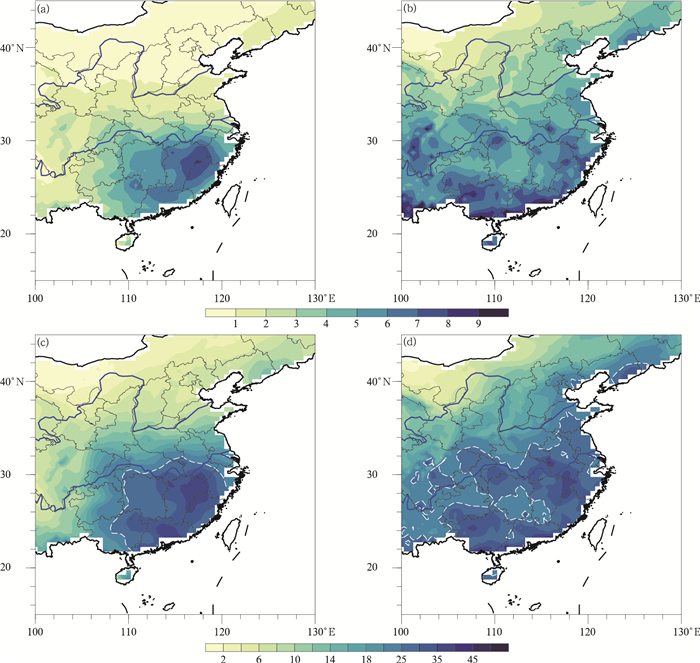
|
| 图 2 中国东部(a)春季、(b)夏季气候态(1961—2010年)降水分布(单位:mm/d);(c、d)同(a、b),但为极端降水阈值分布 (白色虚线表示25 mm/d等降水量线) Figure 2 Distributions of (a) spring and (b) summer climatological mean precipitation (1961-2010) over eastern China (unit: mm/d). (c, d) Same as (a, b) but for extreme precipitation thresholds (the white dashed contours indicate the 25 mm/d precipitation lines) |
总体而言,极端降水阈值的分布与气候态降水基本一致。然而,在超强厄尔尼诺事件衰减年,ENSO信号对中国东部降水有着明显的调控作用。从3次超强厄尔尼诺事件异常降水的合成结果来看,衰减年春季,几乎整个东部地区的降水都显著增多,大值区域主要在江淮流域以及华南部分地区(图 3a);而普通厄尔尼诺事件中春季异常降水无论是振幅还是覆盖范围都要差很多(图 3c)。夏季,超强厄尔尼诺事件中北方降水仍旧偏多,而华南已经转为较弱的负异常;在长江流域沿线,则存在着一条显著的降水正异常大值带(图 3b),而普通厄尔尼诺事件长江中下游降水已经变成负异常(图 3d)。可见中国东部季节平均降水对超强厄尔尼诺事件的响应基本以增多为主,并且,长江流域的降水正异常最为显著且持久。那么,基于这样的季节趋势,单日极端降水事件分布是否也会有类似的变化呢?为了直观地考察其发生概率的变化特征,参考前人的方法(Xavier,et al,2014;Hsu,et al,2016;Ren,et al,2017),计算了超强厄尔尼诺事件衰减年春、夏季极端降水发生概率的百分比变化ΔPSE。它反映了在超强厄尔尼诺影响背景下,极端降水发生概率相对于正常年份的变化

|
(2) |

|
| 图 3 超强厄尔尼诺事件衰减年(a)春季、(b)夏季合成的中国东部降水异常(单位:mm/d,划线区域为通过0.05水平显著性t检验);(c、d)同(a、b),但为普通厄尔尼诺事件合成结果 Figure 3 Composite seasonal precipitation anomalies (unit: mm/d, the slashed areas indicate the anomalies exceed 0.05 significance level of t-test) over eastern China during the decaying phase of super El Niño events (a. spring, b. summer; c, d. same as a, b, except for regular El Niño events) |
式中,PSE为超强厄尔尼诺年极端降水事件发生的概率,实际计算时使用所挑选超强厄尔尼诺衰减年各季节逐日降水量x超过极端降水阈值xt(即前述各季节雨日95百分位降水量)的频率代替。同样Pcli为在气候态常规情况下极端降水发生的概率,使用所有年份逐日降水量值超过极端降水阈值的频率代替。
对每一年极端降水事件发生情况计算百分比变化之后,给出了超强厄尔尼诺年合成的概率变化分布(图 4),以分析超强厄尔尼诺事件对极端降水产生的共性影响。衰减年春季,中国东部绝大部分地区极端降水发生概率均有所提升(图 4a)。与季节平均降水变化规律类似,极端降水变化最显著的区域也主要在黄河流域和东北地区,这些地区春季气候态降水量基数小,降水稍有增加就可以达到极端水平。极端降水阈值较高的长江中下游沿海以及华南部分地区,最高也提升了接近100%。夏季(图 4b),北方随着整体极端降水阈值的提高以及ENSO影响的减弱,极端降水事件发生概率迅速减小,但长江流域仍然高出常年约1倍,并且高概率区域向内陆延伸。整体呈现出长江流域偏高,而其两侧的华北与华南相对偏低的纬向带状分布特征。这也是超强厄尔尼诺衰减年夏季长江流域容易发生洪涝灾害的原因之一。

|
| 图 4 超强厄尔尼诺事件衰减年(a)春季、(b)夏季合成的中国东部极端降水发生概率百分比变化(单位:%,划线区域表示通过0.05水平显著性t检验);(c、d)同(a、b),但为普通厄尔尼诺事件合成结果 Figure 4 Composite seasonal percentage changes in probability of extreme precipitation over eastern China during the decaying phase of super El Niño events (unit: %, the slashed areas indicate the anomalies exceed 0.05 significance level of t-test) (a. spring, b. summer; c, d. same as a, b, except for regular El Niño events) |
作为比较,给出了20世纪60年代之后普通厄尔尼诺事件对应季节的极端降水发生概率百分比变化(图 4c、d)。合成结果几乎没有区域通过显著性t检验,说明普通厄尔尼诺事件对极端降水影响弱且不稳定。对比而言,衰减年春季,不同强度厄尔尼诺事件的影响在中国北方分布还有些相似;而夏季则差异明显,普通厄尔尼诺事件长江流域极端降水发生概率反而减小,与其季节平均降水偏少的特征相符,这体现了超强事件影响的独特性。综上所述,超强厄尔尼诺衰减年春、夏季,中国东部极端降水发生概率相比常年变化明显,特别是长江流域灾害性天气发生的可能性显著增大,这种变化的可能成因尚需进一步探讨。
4 超强厄尔尼诺事件影响极端降水的可能机制强降水事件的频繁发生依赖大尺度环流背景的支持(O'Gorman,et al,2009),图 5给出了合成的整层积分水汽通量异常及其散度的水平分布。超强厄尔尼诺事件衰减年春季,西北太平洋海面上有明显的异常反气旋存在,在其西北侧来自中国南海和西太平洋的异常水汽向北输送,使得从华南延伸至日本海南部均有大量水汽汇聚(图 5a)。除了水汽条件之外,剧烈的上升运动也是强降水过程不可或缺的要素。从衰减年春季110°—120°E平均的垂直方向水汽通量异常环流可以看到(图 6a),EQ—10°N表现为强下沉运动,对应西北太平洋的强反气旋活动,通过它大量水汽被输送到赤道外,在20°—35°N存在显著的异常上升。这种水汽丰沛、对流强盛的背景条件为中国东部极端降水的发生、发展提供了有力支持。相对而言,普通厄尔尼诺事件衰减年春季中国东部地区水汽通量异常辐合与上升都不明显(图 5c、6c)。夏季,虽然中东太平洋的厄尔尼诺响应已经消失,但是西北太平洋反气旋仍然存在并略向西扩张,同时在其东北侧日本岛上空产生了一个异常气旋,呈现类似东亚-太平洋型(EAP)遥相关分布(黄荣辉等,2006)。这样的异常环流结构使得水汽输送异常沿长江流域呈现纬向带状辐合,而在华南、华北呈偏辐散的特征(图 5b)。从图 6b的垂直环流上亦可看出,在长江流域上空仍然保持着较强的上升运动趋势,因此,超强厄尔尼诺衰减年夏季该区域上空环流背景仍然有利于极端降水事件发生。普通厄尔尼诺事件衰减年夏季尽管西北太平洋有微弱的反气旋存在但是位置相对偏东偏南(图 5d),这个反气旋可能是厄尔尼诺转相后中东太平洋的冷异常海温或者局地海-气相互作用带来的(Stuecker,et al,2015b),垂直方向长江流域上空水汽输送表现为异常下沉(图 6d),对极端降水事件的发生并无明显影响。
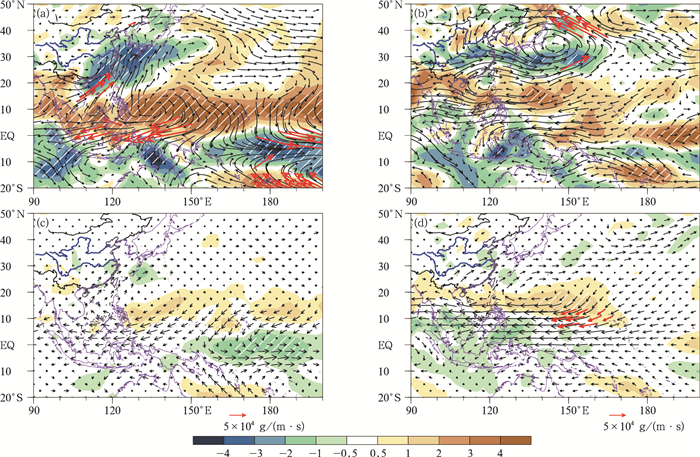
|
| 图 5 超强厄尔尼诺事件衰减年(a)春季、(b)夏季合成的整层水汽通量距平(矢线)及其散度(色阶,单位:10-2 g/(m2·s))分布 (红色矢量及划线区域表示通过0.05水平显著性t检验);(c、d)同(a、b),但为普通厄尔尼诺事件合成结果 Figure 5 Composite seasonal vertically integrated moisture transport anomalies (vectors) and their divergences (shadings, unit: 10-2 g/(m2·s)) during the decaying phase of super El Niño events (a. spring, b. summer; the slashed areas and red vectors indicate the anomalies exceed 0.05 significance level of t-test); c, d. same as a, b, except for regular El Niño events) |
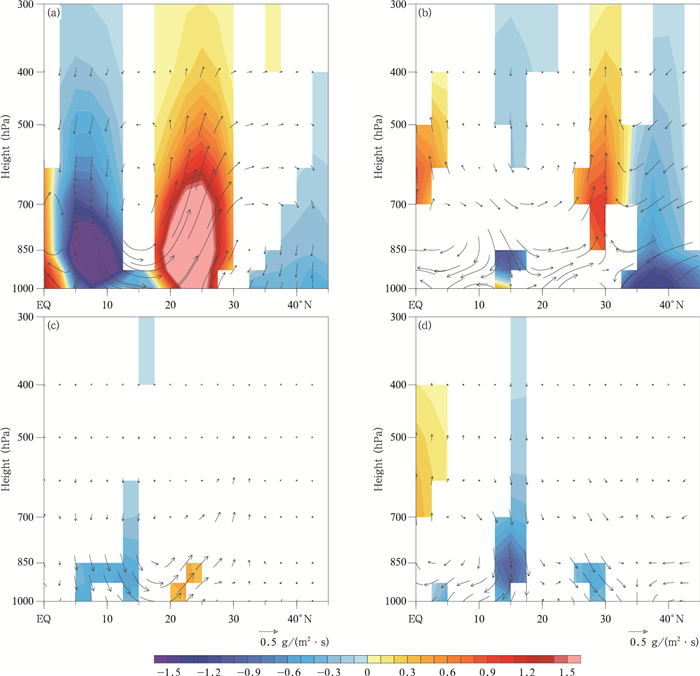
|
| 图 6 超强厄尔尼诺事件衰减年(a)春季、(b)夏季110°—120°E平均的垂向水汽通量异常环流(矢线,其中垂直分量已扩大100倍并用色阶(单位:g/(m2·s))标出其通过0.05水平显著性t检验部分);(c、d)同(a、b),但为普通厄尔尼诺事件合成结果 Figure 6 Composite seasonal vertical moisture transport anomalies averaged over 110°-120°E during the decaying phase of super El Niño events (vectors, the vertical components have been multiplied by a factor of 100, and those exceeding 0.05 significance level of t-test are highlighted by the shadings (unit: g/(m2·s))) (a. spring, b. summer; c, d. Same as a, b, except for regular El Niño events) |
以往研究已经表明,ENSO除了自身的直接影响,其衍生的C-mode也对东亚地区气候异常有着非常重要的影响。为了深入分析超强厄尔尼诺事件对中国东部极端降水影响的可能机制,需要分析C-mode在其中所起的作用及其与ENSO自身影响的联系。为此,使用1961—2010年各季节平均的标准化Nino3.4和Nino-A两个指数序列多元回归同期的异常水汽通量场,再将对应的回归系数乘上各自指数序列得到每年的重构结果,然后将超强厄尔尼诺年的结果合成,得到超强厄尔尼诺事件期间ENSO自身影响以及C-mode各自对水汽通量的贡献。由图 7可知,超强厄尔尼诺事件衰减年春季,ENSO自身影响与C-mode的影响都为中国东部地区贡献了大量的水汽。其中ENSO自身的响应在赤道太平洋地区向东水汽输送明显,表现为经典的ENSO影响结构,在西北太平洋地区有反气旋结构存在,使得大量水汽被输送到中国东部和南部(图 7a)。而C-mode的响应在赤道地区表现为向西水汽输送异常,然而,在西北太平洋却与ENSO自身直接影响类似地表现为显著的反气旋异常,得以将赤道地区的水汽向东亚地区输送(图 7c)。垂向水汽通量异常的响应同样可以分解为两个部分(图 8),衰减年春季,ENSO自身影响在热带地区主要以下沉气流为主,向北输送后在亚洲东部上空出现明显的上升运动(图 8a);而C-mode影响在整个中低纬度地区都呈现上升运动,以中国华南地区对应的20°N左右为最强(图 8c)。夏季,厄尔尼诺事件对应的东太平洋正海温异常已经消失,ENSO自身对东亚的影响基本可以忽略(图 7b、8b);而C-mode通过局地海-气相互作用可以将异常信号存储到海洋中,引起Nino-A相关区域海温持续异常,从而将其影响延续到厄尔尼诺衰减年的夏季(Stuecker,et al,2015b)。与其相联系的大气环流场中,西北太平洋反气旋结构仍然存在,源自太平洋和中国南海的水汽最终输送到长江流域及其东部海面(图 7d)。在垂直环流场上,与C-mode相关的大气场在长江流域对应的30°N左右维持了较强的上升运动(图 8d)。综上所述,超强厄尔尼诺事件对衰减年春、夏季降水背景的影响可以分为ENSO自身直接影响和衍生的C-mode影响两个部分,春季两个部分都对中国东部地区的水汽累积和上升运动倾向做出了贡献;夏季,则主要是C-mode的作用使得长江流域仍然维持着有利于极端降水事件发生的水汽和环流条件。在对普通厄尔尼诺事件的水汽背景做类似分解时,发现只有衰减年春季Nino3.4指数的重构结果比较显著(图略),说明普通厄尔尼诺事件中只有ENSO自身影响发挥了一定的作用。
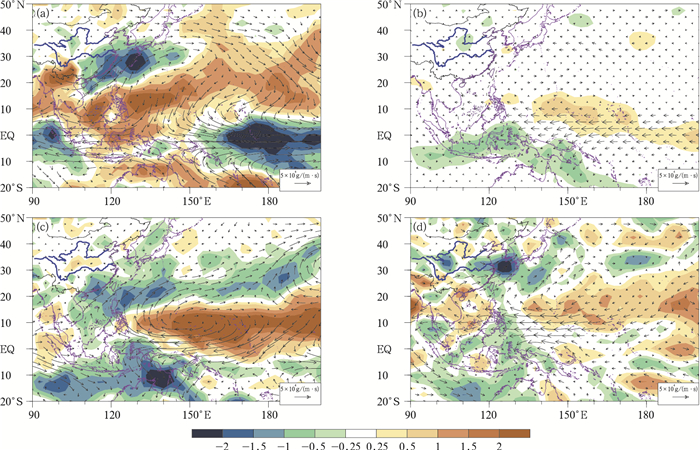
|
| 图 7 超强厄尔尼诺事件衰减年(a)春季、(b)夏季平均的Nino3.4指数偏回归重构的水汽通量距平(矢线)及其散度(色阶,单位:10-2 g/(m2·s))分布;(c、d)同(a、b),但为Nino-A指数偏回归重构的结果 Figure 7 Reconstruction of vertically integrated moisture transport (vectors) and its divergence anomalies (shadings, unit: 10-2 g/(m2·s)) during the decaying phase of super El Niño events using partial regression with only Nino3.4 index (a. spring, b. summer; c, d. same as a, b, except with only Nino-A index) |

|
| 图 8 超强厄尔尼诺事件衰减年(a)春季、(b)夏季平均的Nino3.4指数偏回归重构的110°—120°E平均的垂向水汽通量异常环流(矢线,其中垂直分量已扩大100倍并用色阶(单位:g/(m2·s))标出);(c、d)同(a、b),但为Nino-A指数偏回归重构的结果 Figure 8 Reconstruction of vertical moisture transport anomalies averaged over 110°-120°E during the decaying phase of super El Niño events using partial regression with only Nino3.4 index (the vertical components have been multiplied by a factor of 100 and highlighted by the shadings (unit: g/(m2·s))) (a. spring, b. summer; c, d. same as a, b, except with only Niño-A index) |
从上述分析可知,超强厄尔尼诺事件衰减年中国东部地区有充沛的水汽向北输送。在此基础上,每当有来自北方的冷空气向南活动时,便可能引发一次强对流甚至极端降水事件。为此,诊断了衰减年对流层中上层逐日经向风场相比于气候态风场的方差异常变化(图 9)。春季,东部沿海地区方差比常年明显增大,对流层中上层高频经向风异常活跃,这意味着低层冷空气将被频繁地引导南下,出现极端降水事件的几率随之上升(图 9a)。夏季,长江流域也处于经向风变化最剧烈的区域之内,同时这里还是水汽输送的大值区,频繁的冷、暖空气交汇很可能导致强对流事件大幅度增多(图 9b)。相对的,在普通厄尔尼诺事件中,南方地区对流层中上层异常经向风的活动反而是偏少的(图 9c、d)。因此,超强厄尔尼诺事件引发的经向风场异常活跃也为极端降水频繁发生提供了支持。当然,进一步的机理问题尚待深入研究。
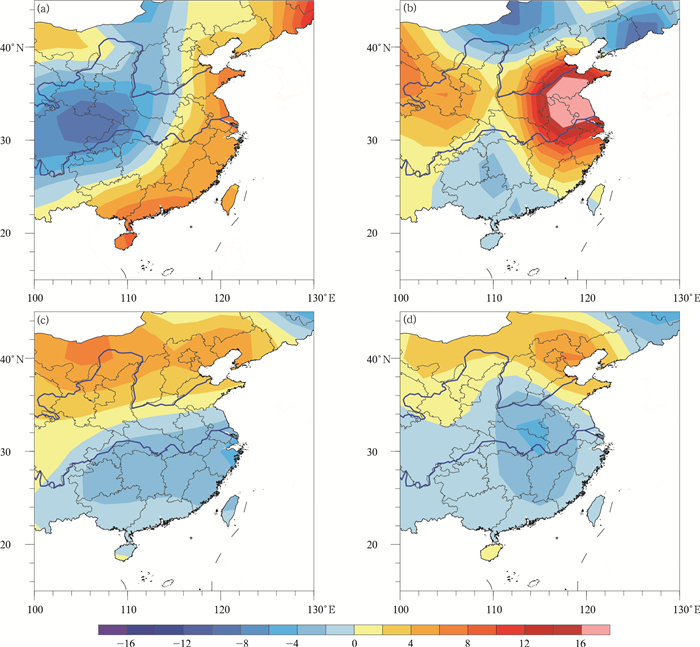
|
| 图 9 超强厄尔尼诺事件衰减年(a)春季、(b)夏季中国东部500—200 hPa逐日经向风方差与对应季节气候态经向风方差的差值(单位:m2/s2)分布;(c、d)同(a、b),但为普通厄尔尼诺事件合成结果 Figure 9 Difference (unit: m2/s2) of 500-200 hPa daily meridional wind variance between during the decaying phase of super El Niño events and in climatology over eastern China (a. spring, b. summer; c, d. same as a, b, except for regular El Niño events) |
利用中国逐日降水格点资料,考察了超强厄尔尼诺事件影响下中国东部春、夏季极端降水发生概率的变化特征,并结合超强事件自身及其衍生模态(C-mode)的影响深入分析了这些特征的可能成因。主要结论如下:
(1) 超强厄尔尼诺事件衰减年春季,整个中国东部尤其是江淮以北地区,极端降水事件发生概率均显著增大,南方地区相比正常年份最高也有接近100%的提升;同年夏季,华北、华南地区极端降水事件发生概率降低,而长江流域发生极端降水的概率依然比正常年份高出约1倍。
(2) 超强厄尔尼诺事件可以通过调控亚洲东部地区衰减年春、夏季环流背景为极端降水事件的发生提供有利条件。春季,ENSO自身直接影响使得暖湿气流在亚洲东部大量汇聚并上升,同时其衍生的C-mode也通过西北太平洋反气旋促进赤道地区的水汽向东亚地区输送;夏季,ENSO自身影响减弱甚至消失,但C-mode的影响依旧显著,长江流域上空仍然表现出水汽汇聚、上升运动较强的特征。
(3) 超强厄尔尼诺事件还能通过某种途径引起春、夏季中国东部对流层中上层经向风场的异常活动,引起北方冷空气频繁南下与背景场丰沛的北上暖湿气流相互作用,可能导致强对流事件发生次数增多,从而为极端降水事件的频发提供有利支持。
极端降水事件的物理成因十分复杂,超强厄尔尼诺事件通过影响月、季尺度环流背景可以为其创造非常有利的发生条件,但最终决定其发生频次的还是天气尺度要素的变化。ENSO对这些高频变化的激发机制还需要进一步研究。例如,衰减年东亚地区高频经向风的异常活跃,可能与强厄尔尼诺事件对大气加热强迫促进高、低纬度间的经向热力交换(Lee,2012)有关, 可能是通过引发如太平洋北美型遥相关等大气环流型异常间接导致的(Renwick,et al,1996;Chan,et al,2005), 也可能与副热带“丝绸之路”波列的异常活动存在联系(Lu, et al, 2002)。
ENSO作为具有全球影响的年际信号,可以与局地气候变率相互作用产生出不同频率的衍生模态(Stuecker,et al,2015a),这些衍生模态对上述天气要素的影响也需要继续探索。另外,文中采用合成分析强调了ENSO的强度对极端降水产生的共性影响,但即便同样是超强厄尔尼诺事件,不同个例太平洋异常海温时、空演变特征的细微偏差也可能导致其在外赤道地区的气候影响不同(Rao,et al,2017;Liu, et al, 2018)。鉴于有可靠记录以来发生的超强厄尔尼诺事件较少,未来还需要利用能够同时较好地模拟ENSO事件和C-mode的模式(Ren,et al,2016),来进一步模拟超强厄尔尼诺及其衍生模态对极端事件的影响,从而加深对超强厄尔尼诺事件气候影响问题的认识。
| 毕宝贵, 张小玲, 代刊. 2017. 2016年超强厄尔尼诺背景下的强对流和极端降水天气特点. 科学通报, 62(9): 928–937. Bi B G, Zhang X L, Dai K. 2017. Characteristics of 2016 severe convective weather and extreme rainfalls under the background of super El Niño. Chinese Sci Bull, 62(9): 928–937. (in Chinese) |
| 陈海山, 范苏丹, 张新华. 2009. 中国近50 a极端降水事件变化特征的季节性差异. 大气科学学报, 32(6): 744–751. Chen H S, Fan S D, Zhang X H. 2009. Seasonal differences of variation characteristics of extreme precipitation events over China in the last 50 years. Trans Atmos Sci, 32(6): 744–751. (in Chinese) |
| 符淙斌, 滕星林. 1988. 我国夏季的气候异常与埃尔尼诺/南方涛动现象的关系. 大气科学, 12(S1): 133–141. Fu C B, Teng X L. 1988. Climate anomalies in China associated with El Niño/Southern Oscillation. Chinese J Atmos Sci, 12(S1): 133–141. DOI:10.3878/j.issn.1006-9895.1988.t1.11 (in Chinese) |
| 国家质量监督检验检疫总局. 2017. 厄尔尼诺/拉尼娜事件判别方法, GB/T 33666-2017. 北京: 中国标准出版社. General Administration of Quality Supervision, Inspection and Quarantine of the People's Republic of China. 2017. Identification Method for El Niño/La Nia Events, GB/T 33666-2017. Beijing: Standards Press of China. |
| 黄荣辉, 蔡榕硕, 陈际龙, 等. 2006. 我国旱涝气候灾害的年代际变化及其与东亚气候系统变化的关系. 大气科学, 30(5): 730–743. Huang R H, Cai R S, Chen J L, et al. 2006. Interdecadal variations of drought and flooding disasters in China and their association with the East Asian climate system. Chinese J Atmos Sci, 30(5): 730–743. (in Chinese) |
| 金祖辉, 陶诗言. 1999. ENSO循环与中国东部地区夏季和冬季降水关系的研究. 大气科学, 23(6): 663–672. Jin Z H, Tao S Y. 1999. A study on the relationships between ENSO cycle and rainfalls during summer and winter in Eastern China. Chinese J Atmos Sci, 23(6): 663–672. (in Chinese) |
| 李海燕, 张文君, 何金海. 2016. ENSO及其组合模态对中国东部各季节降水的影响. 气象学报, 74(3): 322–334. Li H Y, Zhang W J, He J H. 2016. Influences of ENSO and its combination mode on seasonal precipitation over eastern China. Acta Meteor Sinica, 74(3): 322–334. DOI:10.11676/qxxb2016.025 (in Chinese) |
| 李威, 翟盘茂. 2009. 中国极端强降水日数与ENSO的关系. 气候变化研究进展, 5(6): 336–342. Li W, Zhai P M. 2009. Relationship between ENSO and frequency of extreme precipitation days in China. Adv Climate Change Res, 5(6): 336–342. (in Chinese) |
| 刘永强, 丁一汇. 1995. ENSO事件对我国季节降水和温度的影响. 大气科学, 19(2): 200–208. Liu Y Q, Ding Y H. 1995. Reappraisal of the influence of ENSO events on seasonal precipitation and temperature in China. Chinese J Atmos Sci, 19(2): 200–208. (in Chinese) |
| 任国玉, 封国林, 严中伟. 2010. 中国极端气候变化观测研究回顾与展望. 气候与环境研究, 15(4): 337–353. Ren G Y, Feng G L, Yan Z W. 2010. Progresses in observation studies of climate extremes and changes in mainland China. Climatic Environ Res, 15(4): 337–353. (in Chinese) |
| 任宏利, 王润, 翟盘茂, 等. 2017. 超强厄尔尼诺事件海洋学特征分析与预测回顾. 气象学报, 75(1): 1–18. Ren H L, Wang R, Zhai P M, et al. 2017. Upper-ocean dynamical features and prediction of the super El Niño in 2015/2016:A comparison with 1982/1983 and 1997/1998. Acta Meteor Sinica, 75(1): 1–18. DOI:10.11898/1001-7313.20170101 (in Chinese) |
| 邵勰, 周兵. 2016. 2015/2016年超强厄尔尼诺事件气候监测及诊断分析. 气象, 42(5): 540–547. Shao X, Zhou B. 2016. Monitoring and diagnosis of the 2015/2016 super El Niño event. Meteor Mon, 42(5): 540–547. DOI:10.7519/j.issn.1000-0526.2016.05.003 (in Chinese) |
| 陶诗言, 张庆云. 1998. 亚洲冬夏季风对ENSO事件的响应. 大气科学, 22(4): 399–407. Tao S Y, Zhang Q Y. 1998. Response of the Asian winter and summer monsoon to ENSO events. Sci Atmos Sinica, 22(4): 399–407. (in Chinese) |
| 王苗, 郭品文, 邬昀. 2013. ENSO对我国东部极端降水的季节影响. 长江流域资源与环境, 22(6): 808–816. Wang M, Guo P W, Wu Y. 2013. Impact of ENSO on the seasonal extreme rainfall over eastern China. Resour Environ Yangtze Basin, 22(6): 808–816. (in Chinese) |
| 袁媛, 高辉, 贾小龙, 等. 2016. 2014-2016年超强厄尔尼诺事件的气候影响. 气象, 42(5): 532–539. Yuan Y, Gao H, Jia X L, et al. 2016. Influences of the 2014-2016 super El Niño event on climate. Meteor Mon, 42(5): 532–539. DOI:10.7519/j.issn.1000-0526.2016.05.002 (in Chinese) |
| 翟盘茂, 潘晓华. 2003. 中国北方近50年温度和降水极端事件变化. 地理学报, 58(S1): 1–10. Zhai P M, Pan X H. 2003. Change in extreme temperature and precipitation over northern China during the second half of the 20th century. Acta Geogr Sinica, 58(S1): 1–10. (in Chinese) |
| 翟盘茂, 余荣, 郭艳君, 等. 2016. 2015/2016年强厄尔尼诺过程及其对全球和中国气候的主要影响. 气象学报, 74(3): 309–321. Zhai P M, Yu R, Guo Y J, et al. 2016. The strong El Niño in 2015/2016 and its dominant impacts on global and China's climate. Acta Meteor Sinica, 74(3): 309–321. DOI:10.11676/qxxb2016.049 (in Chinese) |
| 张文君, 耿新. 2016. 2015/2016年超强El Niño局地海气特征及其特殊性. 大气科学学报, 39(6): 778–787. Zhang W J, Geng X. 2016. Characteristics and particularity of local air-sea processes for the 2015/2016 super El Niño event. Trans Atmos Sci, 39(6): 778–787. (in Chinese) |
| 赵振国. 1996. 厄尔尼诺现象对北半球大气环流和中国降水的影响. 大气科学, 20(4): 422–428. Zhao Z G. 1996. Impact of El Niño events on atmospheric circulations in the northern hemisphere and precipitation in China. Sci Atmos Sinica, 20(4): 422–428. (in Chinese) |
| Chan J C L, Zhou W. 2005. PDO, ENSO and the early summer monsoon rainfall over south China. Geophys Res Lett, 32(8): L08810. |
| Chen L, Li T, Behera S K, et al. 2016. Distinctive precursory air-sea signals between regular and super El Niños. Adv Atmos Sci, 33(8): 996–1004. DOI:10.1007/s00376-016-5250-8 |
| Dee D P, Uppala S M, Simmons A J, et al. 2011. The ERA-Interim reanalysis:Configuration and performance of the data assimilation system. Quart J Roy Meteor Soc, 137(656): 553–597. DOI:10.1002/qj.v137.656 |
| Gong D Y, Wang S W. 1999. Impacts of ENSO on rainfall of global land and China. Chin Sci Bull, 44(9): 852–857. DOI:10.1007/BF02885036 |
| Hsu P C, Lee J Y, Ha K J. 2016. Influence of boreal summer intraseasonal oscillation on rainfall extremes in southern China. Int J Climatol, 36(3): 1403–1412. DOI:10.1002/joc.2016.36.issue-3 |
| Huang R H, Wu Y F. 1989. The influence of ENSO on the summer climate change in China and its mechanism. Adv Atmos Sci, 6(1): 21–32. DOI:10.1007/BF02656915 |
| Kalnay E, Kanamitsu M, Kistler R, et al. 1996. The NCEP/NCAR 40-year reanalysis project. Bull Amer Meteor Soc, 77(3): 437–472. DOI:10.1175/1520-0477(1996)077<0437:TNYRP>2.0.CO;2 |
| Latif M, Semenov V A, Park W. 2015. Super El Niños in response to global warming in a climate model. Climatic Change, 132(4): 489–500. DOI:10.1007/s10584-015-1439-6 |
| Lee S. 2012. Testing of the tropically excited arctic warming mechanism (TEAM) with traditional El Niño and La Nia. J Climate, 25(12): 4015–4022. DOI:10.1175/JCLI-D-12-00055.1 |
| Liu B Q, Zhu C W, Su J Z, et al. 2018. Why was the western Pacific subtropical anticyclone weaker in late summer after the 2015/2016 super El Niño?. Int J Climatol, 38(1): 55–65. DOI:10.1002/joc.5160 |
| Lu R Y, Oh J H, Kim B J. 2002. A teleconnection pattern in upper-level meridional wind over the North African and Eurasian continent in summer. Tellus A, 54(1): 44–55. DOI:10.1034/j.1600-0870.2002.00248.x |
| O'Gorman P A, Schneider T. 2009. The physical basis for increases in precipitation extremes in simulations of 21st-century climate change. Proc Natl Acad Sci USA, 106(35): 14773–14777. DOI:10.1073/pnas.0907610106 |
| Philander S G H. 1983. El Niño southern oscillation phenomena. Nature, 302(5906): 295–301. DOI:10.1038/302295a0 |
| Rao J, Ren R. 2017. Parallel comparison of the 1982/83, 1997/98 and 2015/16 super El Niños and their effects on the extratropical stratosphere. Adv Atmos Sci, 34(9): 1121–1133. DOI:10.1007/s00376-017-6260-x |
| Rasmusson E M, Carpenter T H. 1982. Variations in tropical sea surface temperature and surface wind fields associated with the Southern Oscillation/El Niño. Mon Wea Rev, 110(5): 354–384. DOI:10.1175/1520-0493(1982)110<0354:VITSST>2.0.CO;2 |
| Rayner N A, Parker D E, Horton E B, et al. 2003. Global analyses of sea surface temperature, sea ice, and night marine air temperature since the late nineteenth century. J Geophys Res Atmos, 108(D14): 4407. DOI:10.1029/2002JD002670 |
| Ren H L, Zuo J Q, Jin F F, et al. 2016. ENSO and annual cycle interaction:The combination mode representation in CMIP5 models. Climate Dyn, 46(11-12): 3753–3765. DOI:10.1007/s00382-015-2802-z |
| Ren H L, Ren P F. 2017. Impact of Madden-Julian Oscillation upon winter extreme rainfall in southern China:Observations and predictability in CFSv2. Atmosphere, 8(10): 192. |
| Renwick J A, Wallace J M. 1996. Relationships between North Pacific wintertime blocking, El Niño, and the PNA pattern. Mon Wea Rev, 124(9): 2071–2076. DOI:10.1175/1520-0493(1996)124<2071:RBNPWB>2.0.CO;2 |
| Stuecker M F, Timmermann A, Jin F F, et al. 2013. A combination mode of the annual cycle and the El Niño/Southern Oscillation. Nat Geosci, 6(7): 540–544. DOI:10.1038/ngeo1826 |
| Stuecker M F, Jin F F, Timmermann A. 2015a. El Niño-Southern Oscillation frequency cascade. Proc Natl Acad Sci USA, 112(44): 13490–13495. DOI:10.1073/pnas.1508622112 |
| Stuecker M F, Jin F F, Timmermann A, et al. 2015b. Combination mode dynamics of the anomalous Northwest Pacific anticyclone. J Climate, 28(3): 1093–1111. DOI:10.1175/JCLI-D-14-00225.1 |
| Trenberth K E, Branstator G W, Karoly D, et al. 1998. Progress during TOGA in understanding and modeling global teleconnections associated with tropical sea surface temperatures. J Geophys Res, 103(C7): 14291–14324. DOI:10.1029/97JC01444 |
| Wallace J M, Rasmusson E M, Mitchell T P, et al. 1998. On the structure and evolution of ENSO-related climate variability in the tropical Pacific:Lessons from TOGA. J Geophys Res, 103(C7): 14241–14260. DOI:10.1029/97JC02905 |
| Wang B, Wu R G, Fu X H. 2000. Pacific-East Asian teleconnection:How does ENSO affect East Asian climate?. J Climate, 13(9): 1517–1536. DOI:10.1175/1520-0442(2000)013<1517:PEATHD>2.0.CO;2 |
| Xavier P, Rahmat R, Cheong W K, et al. 2014. Influence of Madden-Julian Oscillation on Southeast Asia rainfall extremes:Observations and predictability. Geophys Res Lett, 41(12): 4406–4412. DOI:10.1002/2014GL060241 |
| Xiao M Z, Zhang Q, Singh V P. 2017. Spatiotemporal variations of extreme precipitation regimes during 1961-2010 and possible teleconnections with climate indices across China. Int J Climatol, 37(1): 468–479. DOI:10.1002/joc.2017.37.issue-1 |
| Zhai P M, Zhang X B, Wan H, et al. 2005. Trends in total precipitation and frequency of daily precipitation extremes over China. J Climate, 18(7): 1096–1108. DOI:10.1175/JCLI-3318.1 |
| Zhang R H, Sumi A, Kimoto M. 1996. Impact of El Niño on the East Asian monsoon:A diagnostic study of the '86/87 and '91/92 events. J Meteor Soc Japan, 74(1): 49–62. DOI:10.2151/jmsj1965.74.1_49 |
| Zhang R H, Sumi A, Kimoto M. 1999. A diagnostic study of the impact of El Niño on the precipitation in China. Adv Atmos Sci, 16(2): 229–241. DOI:10.1007/BF02973084 |
| Zhang R H, Sumi A. 2002. Moisture circulation over East Asia during El Niño episode in northern winter, spring and autumn. J Meteor Soc Japan, 80(2): 213–227. DOI:10.2151/jmsj.80.213 |
| Zhang W J, Jin F F, Stuecker M F, et al. 2016a. Unraveling El Niño's impact on the East Asian monsoon and Yangtze River summer flooding. Geophys Res Lett, 43(21): 11375–11382. DOI:10.1002/2016GL071190 |
| Zhang W J, Li H Y, Stuecker M F, et al. 2016b. A new understanding of El Niño's impact over East Asia:Dominance of the ENSO combination mode. J Climate, 29(12): 4347–4359. DOI:10.1175/JCLI-D-15-0104.1 |
 2018, Vol. 76
2018, Vol. 76


